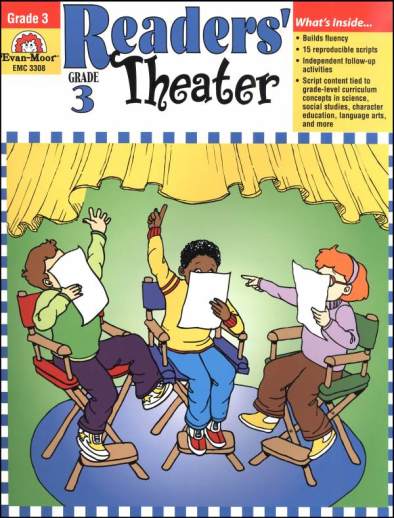We use cookies to make your experience better. To comply with the new e-Privacy directive, we need to ask for your consent to set the cookies. Learn more.
Readers' Theater Grade 3
All your students can shine thanks to the flexible casting options provided in Readers’ Theater, Grade 3. To support struggling readers, cast two or more students in each role; the extra support of choral reading can make an important difference for many students.
Refer to the Readers’ Theater Table of Contents to see how you can connect each of the 15 read-aloud scripts to key content from the Grade 3 curriculum.
Some of the scripts included are:
- “Spider Woman and the Gift of the Loom”—based on a Navajo legend
- “A Wild Day”—a family vacations in a Florida wildlife refuge
- “B. W. Hawkins and the Dinosaur Models”—based on dinosaur discoveries in England in the 1850s
- “The Amazing Laundry Hamper”—this modern adaptation of a Grimm’s tale teaches a lesson in character
- “It Happened at Hull House”—based on Jane Addams’ humanitarian work in the 1890s
- “Davy Crockett: Fact or Legend?”—a television game show looks at the life of an American legend
- and 9 more
So you think that you would like to include drama in your classroom, but you don't have the time or money and it's just not practical for you to stage your own productions? This doesn't mean that you have to lose out on the benefits of dramatic readings and scripts. These books don't provide full productions, but they do offer you a way to incorporate drama without the work of making costumes, sets, and memorizing scripts. Instead, a student or group of students receives their copy of the script and highlights all of their lines (much as they would in an actual performance) and practices reading them expressively, including appropriate voices and expressions. Although students could go through the effort of memorizing the lines, these are just as effective (and less stressful!) used as dramatic readings. Each of these books provides age appropriate stories for kids to present through reading. Background information is provided for you to share with the students beforehand, as are suggestions for "staging," additional research and activities that relate to the story, and vocabulary from the story for you to introduce. Next is the actual script, which can be copied and distributed to the students. After the story are a few pages of related activities, such as coloring, writing, matching, and otherfun worksheets. Assuming my sample copy is representative of the group, there are around 15 scripts provided in each book. Several different genres are enlisted for a variety of readings, including non-fiction, fiction, myths, folk tales like "The Little Red Hen" and "The Three Little Pigs," classics like Romeo and Juliet, and scripts centering around actual people from history like John Chapman and George Washington Carver. You can use these with a single student, include several different children, or even take a role yourself so the whole family can become better dramatic readers. Scripts and activities are reproducible, and answers to the activity questions are included. - Melissa
| Product Format: | Softcover Book |
|---|---|
| Grade: | 3 |
| Brand: | Evan-Moor |
| ISBN: | 9781557998927 |
| Length in Inches: | 11 |
| Width in Inches: | 8.5 |
| Height in Inches: | 0.5 |
| Weight in Pounds: | 0.85 |
Be the first to review this item


This was a required book as part of a co-op we participated in.
To help younger kids learn to read in character in hopes that they will enjoy reading.